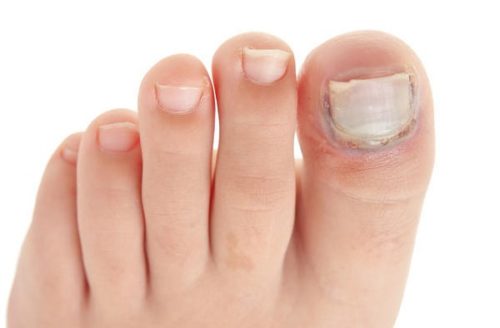10 Ways To Get Rid Of An Ingrown Toenail
Ingrown toenails can cause extreme pain and at times need the attention of a health professional, podiatrist. They can be tricky to treat and may easily get infected if not handled properly. Should your ingrown toenail get infected you should not try to treat it yourself.
However, there are 10 ways to get rid of an ingrown toenail that you can do on your own if the ingrown toenail is not infected. These home remedies will help in preventing the ingrown toenail from recurring and keeping the pain at bay. Below are some ideas that have been proved to work:
1) Foot Soaking
You should try a foot soak. Soak your sore toe in warm salty water for 15 to 20 minutes several times per day. This will help in relieving pain and reducing swelling in the ingrown toenail. For an even faster healing you should try soaking your toenail in raspberry water. After each soak, dry your foot completely.
2) Always Keep Your Foot Dry
Keep your foot always dry except when bathing or soaking it in the salty water bath.
3) Take Pain-Relievers
In case of excruciating pain take an over-the-counter pain relieving medicine. Drugs such as ibuprofen and acetaminophen will be of great help in such conditions.

4) Pull The Skin Away From The Toenail
Carefully pull the skin away from the nail. Use a small nail file or a blunt object that cannot cut or cause injury to your toe. Use tweezers to get the skin out and lift the toenail up every single day.
5) Separate The Toe And Nail Using Moist Cotton
Stuff tiny pieces of clean moist cotton wool between the ingrown toenail and the skin to separate the two and provide a kind of cushion to the skin. You can soak the cotton wool in an antiseptic cleanser or a little water. Make sure to replace the cotton every day to keep the toe from becoming infected. For painful toenail, you should replace the cotton wool every day while checking for infection daily.
6) Use Antibiotic Ointment
To reduce your chances of getting an infection rub your toe with antibiotic ointment. Apply infection-preventing ointment to the site and keep it bandaged. Neosporin works well for such purposes. You should use antibiotic ointment twice a day. After showering in the morning and before going to bed in the evening, apply the antibiotic to the entire foot. This will help deal with infections.
7) Wrap The Toe In A Band-Aid Or Other Bandage
To offer padding and extra protection to the toe cover the sore toe with a Band-Aid or other bandage. You may tie a thin slice of lemon on the toe with gauze and leave it overnight. The acidity of the lemon will help prevent infection as you sleep. You should secure the band aid to the bottom of your toe and pull the skin away from the area where the nail is cutting into the nail bed. This will help decrease pressure in the toenail and promote drainage and drying.
8) Wear Shoes That Are Easy On Your Toe
Choose shoes made of soft fabrics with more room for your toe. Wear sandals more often if you can. Shoes that pinch the toes or place too much pressure on the ingrown toe are not recommended as they can hurt your toenail and cause pain. Do not wear shoes or socks when you are at home to give your toe some air.
9) Inspect Your Toe Carefully For Signs Of Infection
Regularly check your toes for signs and symptoms such as redness, increased pain, swelling, and pus.
10) Visit A Podiatrist
If you identify signs of infection or if your ingrown toenail keeps recurring its high time you saw a health professional by the name of a podiatrist. Make sure you find someone local. For example, if you live in Kansas City, check out a kc podatrist.
Donts:
- Do not remove the cuticles from your toenails because it causes irritation to the toenails making them prone to getting ingrown.
- Refrain from getting pedicures while ingrown toenail is a bother to you. Pedicures can aggravate pain in the skin underneath the nail. Pedicure instruments can be less sanitary and may cause or worsen infections.
- Do not wear shoes that are too small that press on your toenails. This might easily cause the toenails to become ingrown. You should instead opt for wide roomier and bigger shoes instead of smaller and cozier ones. Wear open-toed shoes to reduce pressure on the toe.
- Do not wear colored socks because when your feet sweat the dye might run and the chemicals in it get into your ingrown toenail thus causing an infection. Wear fresh clean socks that are not dyed.
In case your ingrown toenail is swollen or has pus around it then it is most likely to be infected. It is recommended that you see your podiatrist for antibiotics before you insert the cotton to separate the nail and the toe. Antibiotics will reduce infection while the cotton method will help the nail grow back correctly. Should the cotton method along with antibiotic application fail then it is high time you saw your podiatrist because your toenail may need surgical removal.
Make sure that the ingrown toenail is covered and kept clean at all times to avoid serious consequences. The toenail is very susceptible to infections and as such proper sanitation will help in keeping infections at bay. Try trimming or picking off any dry skin off to the side of the affected toe nail. It will feel nice and aid in aerating the region that has been affected. If the area has been infected and has pus just squeeze the puss out and wipe away any puss using a wet tissue or cotton. Leave it open for aeration and do not put a plaster or Band-Aid for it to heal faster.
You should focus on getting rid of the ingrown toenail instead of waiting longer as it will become more painful. Dealing with it in the initial stages is the best and surest cure if you want to avoid any major issues with your foot. Most people will agree that the longer you wait the worse it becomes.


